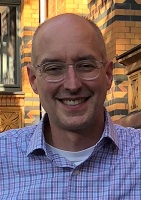National Center for Rehabilitative Auditory Research (NCRAR)
Timothy Hullar, MD
 Email: Timothy.Hullar@va.gov
Email: Timothy.Hullar@va.gov
Telephone: 503-220-8262 x57472
Current appointments:
Research Investigator, NCRAR
Professor, Department of Otolaryngology - Head and Neck Surgery, Oregon Health & Science University
Research interests:
Dr. Hullar is a board-certified otologist and neurotologist practicing at the VA Portland Healthcare System. He graduated from Harvard Medical School and completed his residency in otolaryngology and fellowship in otology and neurotology at Johns Hopkins.
Dr. Hullar’s laboratory currently focuses on the multisensory integration of vestibular and other sensory inputs. One major line of inquiry is how vestibular and visual inputs are aligned in time. Normally, signals from different sensory systems arrive at the brain at separate times even though they derive from the same event. At long distances, the lag between lightning and thunder is obvious but even at short distances there is a difference. The brain is less able to detect this difference in people with certain conditions such as autism, dyslexia, and schizophrenia. Dr. Hullar, in collaboration with Dr. Richard Lewis of Harvard University, is investigating how people with imbalance are able to combine vestibular and visual inputs accurately in the temporal domain. The results will help identify the basic causes for imbalance, people at risk of falling, and develop training techniques to improve balance.
A second major line of inquiry is the effect that environmental sound sources have on balance. Some patients with cochlear implants or hearing aids have noted that their balance is better with their devices in place versus without. This raises the possibility that improving a patient’s audition may improve their balance as well. Dr. Hullar measures people with and without balance and hearing problems both when standing and moving through the environment. The results will help demonstrate how environmental auditory sources contribute to maintaining balance and which people may benefit most from improving their hearing. Dr. Hullar’s other lines of research include cochlear implantation surgery and the comparative anatomy of the labyrinth of marine mammals.
Research projects (Current):
Temporal Synthesis of Vestibular and Extra-Vestibular Sensory Signals.
Principal Investigators: Timothy Hullar, MD and Richard Lewis, MD, PhD (Multi-Site Award)
National Institutes of Health, National Institute on Deafness and Other Communication Disorders. 1 R01 DC017425-01
1/1/2019-12/31/2023
Physiological, Behavioral, and Predictive Correlates of Ototoxicity in Humans.
Principal Investigator: Dawn Konrad-Martin, PhD
Veterans Administration, Office of Rehabilitation Research and Development I01 RX003127-01
10/1/2019-9/30/2023
Rehabilitation of Complex TBI with Sensory Integration Balance Deficits; Can Early Initiation of Rehabilitation with Wearable Sensor Technology Improve Outcomes?
Principal Investigator: Laurie King, PT, PhD
Co-investigator: Timothy Hullar, MD
US Department of Defense W81XWH-17-1-0424
10/1/2017 – 9/30/2021
Selected research publications:
- Seiwerth I, Jonen J, Rahne T, Lauenroth A, Hullar TE, Plontke SK, Schwesig R. Postural regulation and stability with acoustic input in normal-hearing subjects. HNO 2020 (in press)
- Shayman CS, Peterka R, Gallun F, Oh Y, Hullar TE. Frequency-dependent integration of auditory and vestibular cues for self-motion perception. J Neurophys 2020 123(3):936-944
- Shayman S, Ha Y-M, Raz Y, Hullar T. Geographic disparities in access to cochlear implant care within the Veterans Health Administration. Accepted, JAMA Otolaryngol Head Neck Surg 2019 145(10):889-896
- Shayman CS, Seo JH, Oh YH, Lewis RF, Peterka RJ, Hullar TE. The relationship between vestibular sensitivity and multisensory temporal integration. J Neurophys (featured article) 2018 120:1572-1577
- Karim A, Rumalla K, Hullar TE. The effect of spatial auditory landmarks on ambulation. Gait and Posture 2017 60:171-174
- Shayman CS, Earhart GM, Hullar TE. Improvements in gait with hearing aids and cochlear implants. Otol Neurotol 2017 38: 484-486
- Stevens MN, Barbour DL, Gronski MP, Hullar TE. Auditory contributions to maintaining balance. J Vest Res 2016 26:433-438
- Rumalla K, Karim A, Hullar TE. The effect of hearing aids on postural stability Laryngoscope 2015 125(3):720-3
- Malinzak M, Kay R, Hullar T. Locomotor head movements and semicircular canal morphology in primates. Proc Natl Acad Sci U S A. 2012 109(44):17914-9
Selected recent presentations:
- Invited Speaker, American Speech-Language-Hearing Assocation (ASHA) Annual Conference, San Diego, CA, November 2020. “Multisensory Integration Involving Vestibular Inputs”
- Invited Keynote Speaker, Frontiers 2020 (postponed due to Covid19), Hobart, Tasmania, Australia.
- Invited Speaker, American Otological Society Annual Meeting (postponed due to Covid19), Atlanta, GA “Otologic Innovation: The Cautionary Tale of John Epley”
- Invited Speaker, American Auditory Society Annual Conference, Scottsdale, AZ, March 2019
- Invited Keynote Speaker, Hennig Vertigo Symposium, Halle (Saale), Germany, September 2018



















